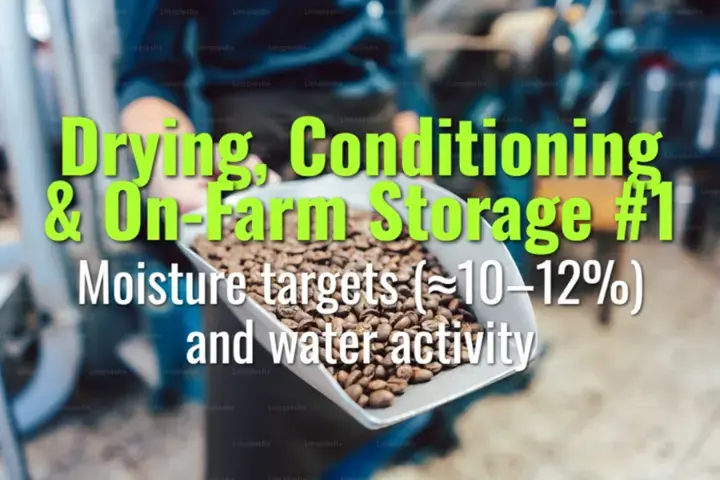Moisture targets (≈10–12%) and water activity
This topic explains the importance of hitting correct moisture content and water activity targets in coffee drying, why they matter for stability and quality, and how farmers measure and manage them.
- Coffee Basics Nerds
- 2 min read
Article 1 of 12 in Drying, Conditioning & On-Farm Storage/

Moisture Content Targets
- Safe storage range: 10–12% moisture.
- Above 12% → high risk of mold growth, mycotoxins, and spoilage.
- Below 10% → beans become brittle, lose aromatics, and suffer quality decline.
Water Activity (aw)
- Definition: Measurement of free water available for microbial activity.
- Target range: 0.55–0.65 for green coffee.
- Even at safe moisture %, high water activity can still allow microbial growth.
- Lower water activity ensures flavor stability and longer shelf life.
Measurement Tools
- Moisture meters: Handheld devices give % readings.
- Water activity meters: More precise, though less common on farms.
- Traditional checks: Bite test (bean hardness) or weight tracking, less accurate but still used.
Why Precision Matters
- Consistency: Accurate drying ensures uniform roasting.
- Food safety: Prevents mold and contamination.
- Market access: Specialty buyers demand documented moisture/aw levels.
Risks of Missing Targets
- Over-drying: Leads to bean breakage during hulling, flat flavor.
- Under-drying: Encourages mold, sour flavors, and early degradation.
- Uneven drying: Causes defects and inconsistent cup profiles.
Best Practices
- Dry coffee slowly and evenly over 10–20+ days (depending on process).
- Use raised beds, solar dryers, or mechanical dryers with careful temperature control (<40°C).
- Monitor multiple samples across beds/lots daily.
- Pair moisture readings with sensory cupping checks.
Lasting Importance
Moisture content and water activity are critical control points in coffee post-harvest management. Hitting the 10–12% and 0.55–0.65 targets ensures coffee is stable, safe, and high-quality through storage, transport, and roasting—protecting both farmer reputation and market value.
You might also like:
- Tags:
- Lasting Importance
- Green Coffee
- Best Practices
- Shelf Life
- Food Safety
- High Quality
- Specialty Buyers
- Moisture Content
- Water Activity
- Uneven Drying
- Raised Beds
- Temperature Control
- Cup Profiles
- Post Harvest
- Market Value
- Microbial Activity
- Solar Dryers
- Mechanical Dryers
- Microbial Growth
- Risk Mold
- Moisture Meters
- Mold Growth
- Buyers Demand
- Market Access
- Safe Storage
- Ensures Coffee
- Ensures Uniform
- Farmer Reputation
- Critical Control
- Sour Flavors
- Dry Coffee
- Drying Leads
- Flat Flavor
- Mold Contamination
- Control Points
- Moisture Readings
- Measurement Tools
- Sensory Cupping
- Beds Solar